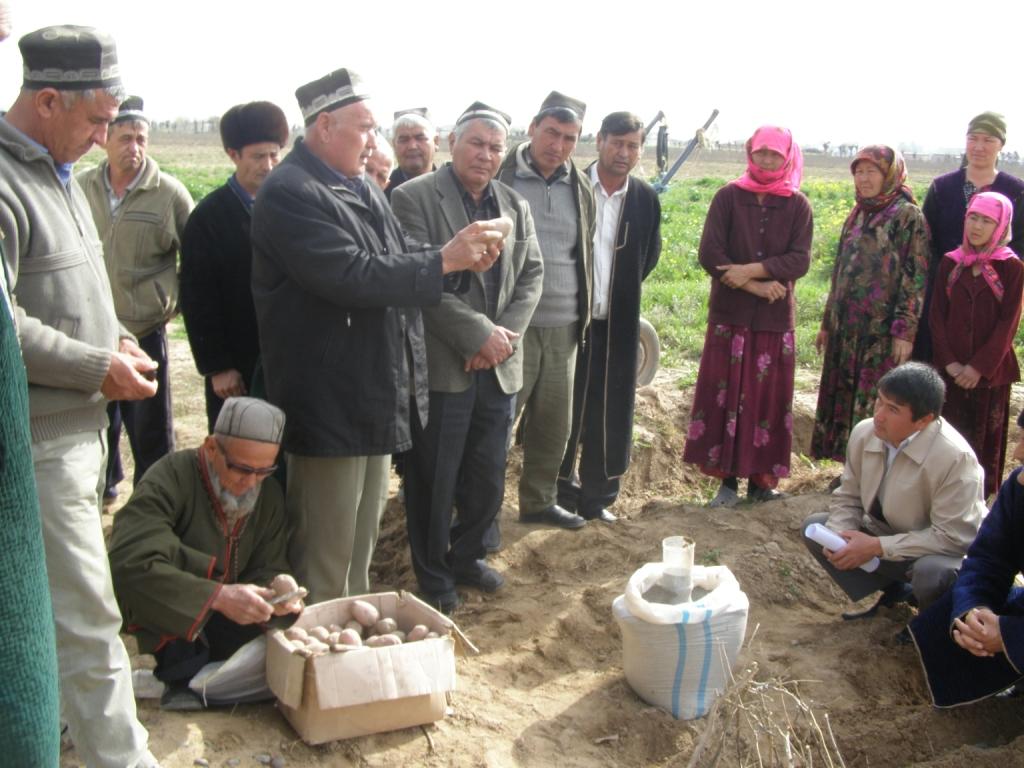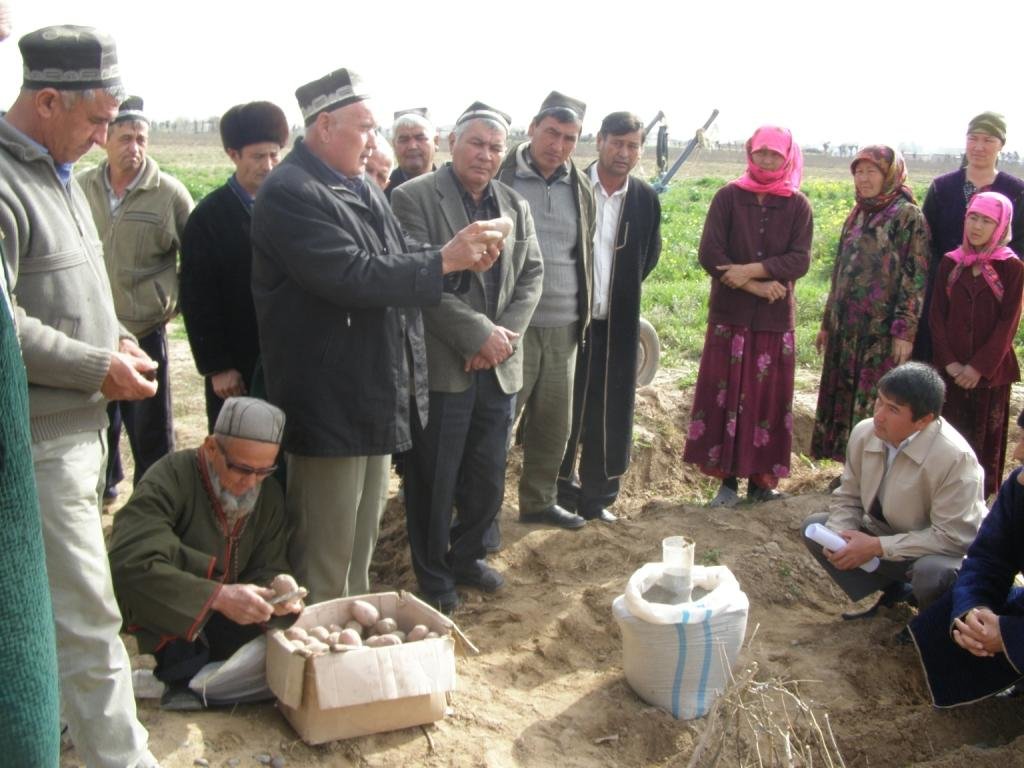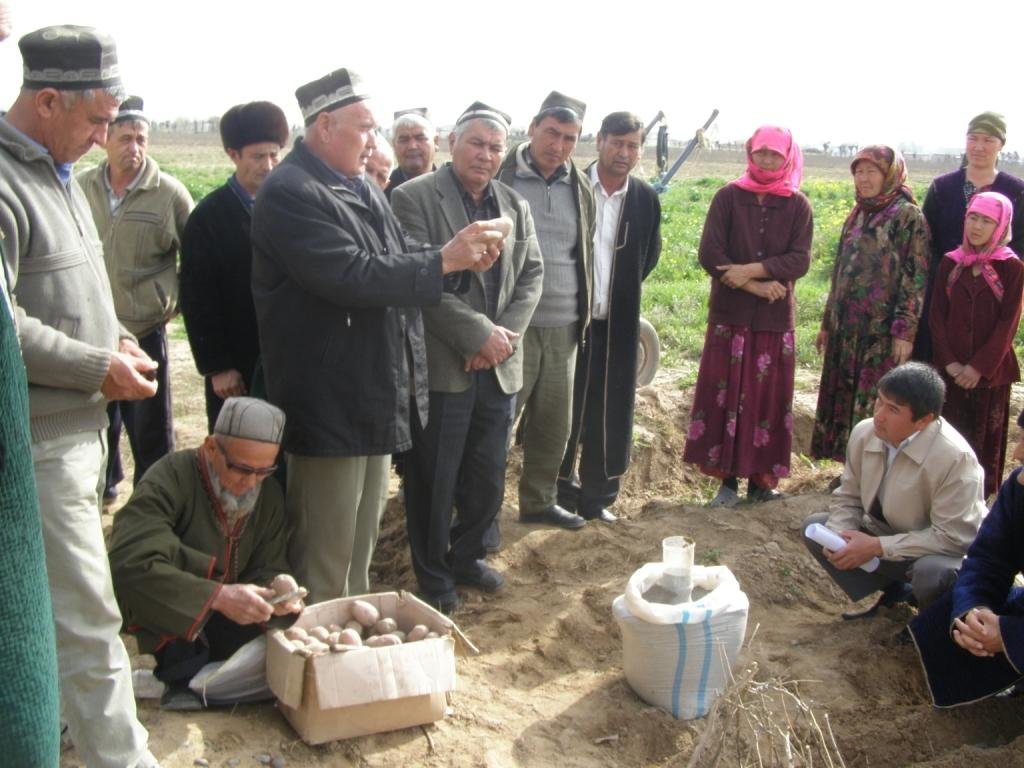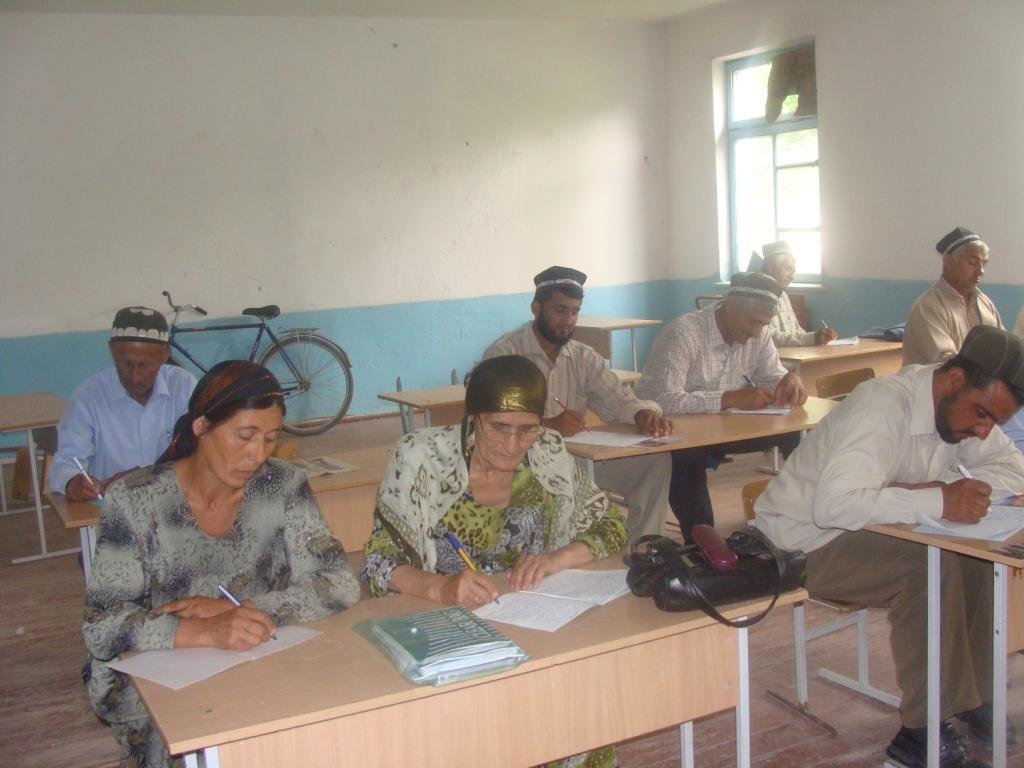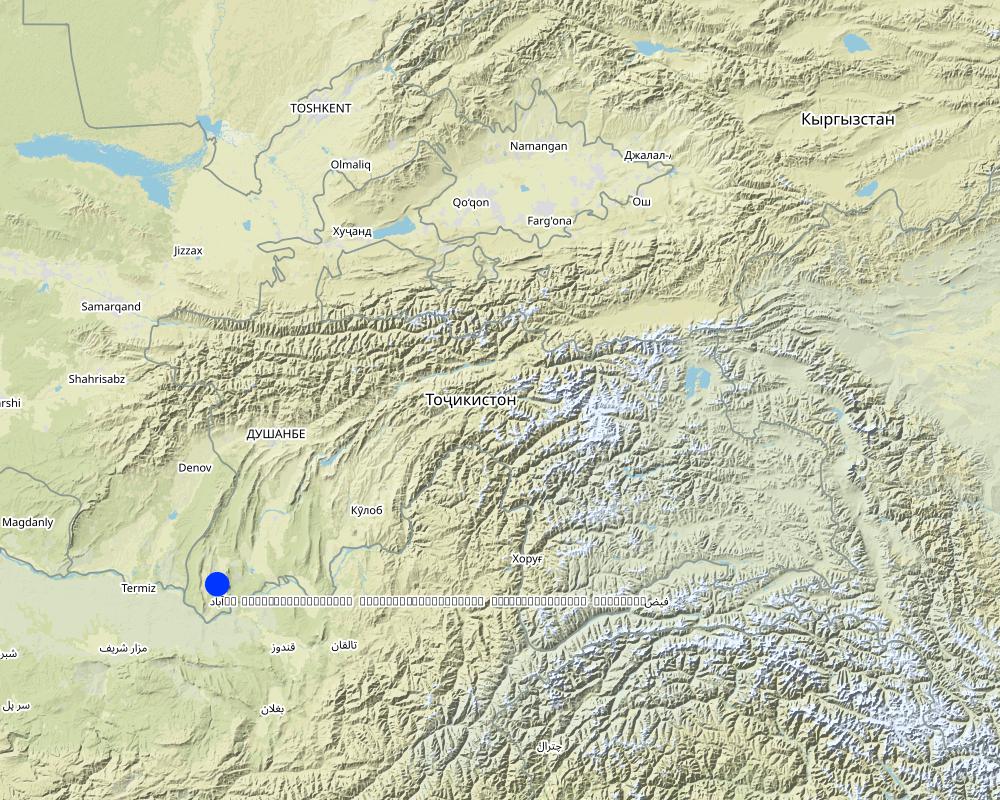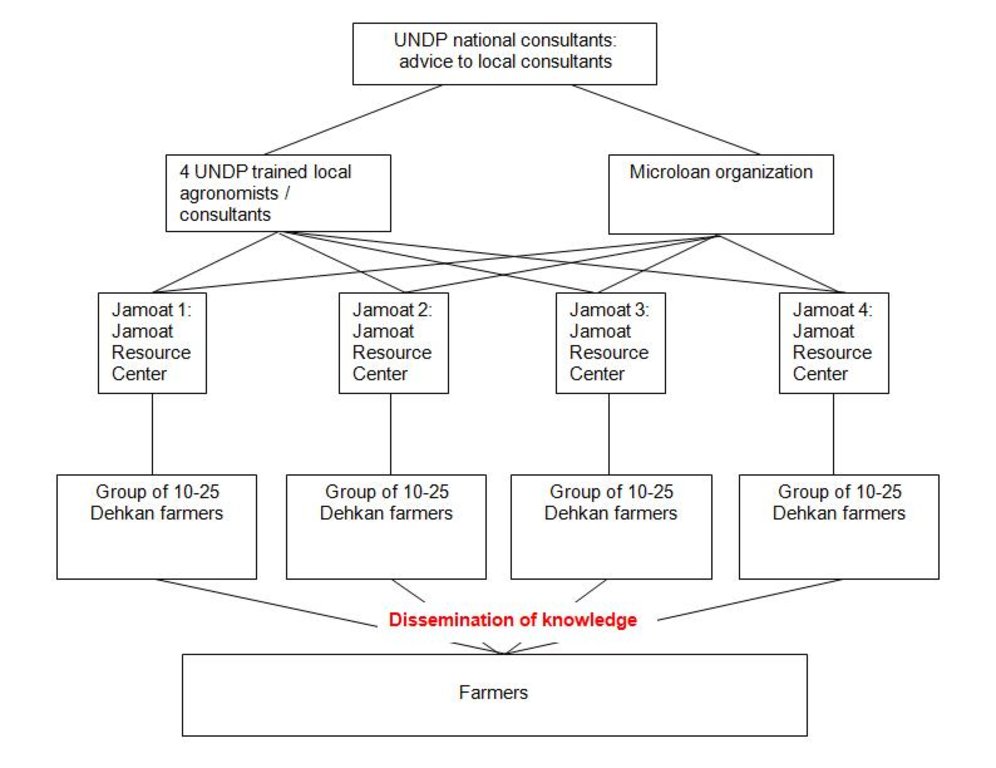Central Asian Countries Initiative for Sustainable Land Management (CACILM) [ຕາຈິກິສະຕານ]
- ການສ້າງ:
- ປັບປູງ:
- ຜູ້ສັງລວມຂໍ້ມູນ: Firdavs Faizulloev
- ບັນນາທິການ: –
- ຜູ້ທົບທວນຄືນ: David Streiff, Alexandra Gavilano, Joana Eichenberger
Фермерские полевые школы
approaches_2439 - ຕາຈິກິສະຕານ
- ສະຫຼຸບສັງລວມຢ່າງທັງໝົດທີ່ເປັນ PDF
- ສັງລວມເປັນບົດ PDF ເພື່ອສັ່ງພິມ
- ສັງລວມເປັນບົດ ຢູ່ໃນ browser
- ບົດສະຫຼຸບ ສະບັບເຕັມ (ບໍ່ມີແບບຟອມ)
- Central Asian Countries Initiative for Sustainable Land Management (CACILM): Nov. 2, 2021 (public)
- Central Asian Countries Initiative for Sustainable Land Management (CACILM): Aug. 8, 2017 (inactive)
- Central Asian Countries Initiative for Sustainable Land Management (CACILM): July 6, 2017 (inactive)
- Фермерские полевые школы: July 6, 2017 (inactive)
ເບິ່ງພາກສ່ວນ
ຂະຫຍາຍທັງໝົດ ຍຸບທັງໝົດ1. ຂໍ້ມູນທົ່ວໄປ
1.2 ລາຍລະອຽດ ການຕິດຕໍ່ ຂອງບຸກຄົນທີ່ຊັບພະຍາກອນ ແລະ ສະຖາບັນ ການມີສ່ວນຮ່ວມ ໃນການປະເມີນຜົນ ແລະ ເອກະສານ ຂອງວິທີທາງ
ຜູ້ຊ່ຽວຊານ ດ້ານການຄຸ້ມຄອງ ທີ່ດິນແບບຍືນຍົງ:
ຜູ້ຊ່ຽວຊານ ດ້ານການຄຸ້ມຄອງ ທີ່ດິນແບບຍືນຍົງ:
ຜູ້ຊ່ຽວຊານ ດ້ານການຄຸ້ມຄອງ ທີ່ດິນແບບຍືນຍົງ:
Urakov Buran
UNDP, Farmers Field School Consultant
ຕາຈິກິສະຕານ
ຊື່ຂອງໂຄງການ ທີ່ອໍານວຍຄວາມສະດວກ ໃນການສ້າງເອກກະສານ ຫຼື ປະເມີນດ້ານແນວທາງ (ຖ້າກ່ຽວຂ້ອງ)
Central Asian Countries Initiative for Land Management (CACILM I)ຊື່ຂອງໂຄງການ ທີ່ອໍານວຍຄວາມສະດວກ ໃນການສ້າງເອກກະສານ ຫຼື ປະເມີນດ້ານແນວທາງ (ຖ້າກ່ຽວຂ້ອງ)
Pilot Program for Climate Resilience, Tajikistan (WB / PPCR)ຊື່ຂອງ ສະຖາບັນການຈັດຕັ້ງ ທີ່ອໍານວຍຄວາມສະດວກ ໃນການສ້າງເອກກະສານ ຫຼື ປະເມີນແນວທາງ (ຖ້າກ່ຽວຂ້ອງ)
United Nations Development Program (United Nations Development Program) - ຕາຈິກິສະຕານຊື່ຂອງ ສະຖາບັນການຈັດຕັ້ງ ທີ່ອໍານວຍຄວາມສະດວກ ໃນການສ້າງເອກກະສານ ຫຼື ປະເມີນແນວທາງ (ຖ້າກ່ຽວຂ້ອງ)
CDE Centre for Development and Environment (CDE Centre for Development and Environment) - ສະວິດເຊີແລນ1.3 ເງື່ອນໄຂ ຂອງການນໍາໃຊ້ເອກກະສານຂໍ້ມູນ ຂອງ WOCAT
ເມື່ອໃດທີ່ໄດ້ສັງລວມຂໍ້ມູນ (ຢູ່ພາກສະໜາມ)?
10/03/2010
ຜູ້ສັງລວມ ແລະ ບັນດາຜູ້ຕອບແບບສອບຖາມ ຍອມຮັບໃນເງື່ອນໄຂ ການນໍາໃຊ້ຂໍ້ມູນເອກະສານ ທີ່ສ້າງຂື້ນ ໂດຍຜ່ານ ອົງການ WOCAT:
ແມ່ນ
1.4 ເອກະສານອ້າງອີງ (ຫຼາຍ) ກັບແບບສອບຖາມ (ຫຼາຍ) ເຕັກໂນໂລຢີ ຂອງດ້ານການຄຸ້ມຄອງ ດິນແບບຍືນຍົງ
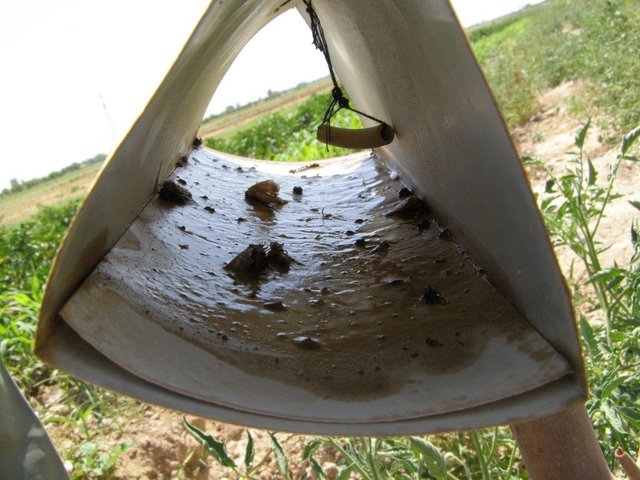
Pest management with pheromone insect traps [ຕາຈິກິສະຕານ]
Coloured pheromone traps are set up in agricultural fields to attract and eradicate flying insect pests.
- ຜູ້ສັງລວມຂໍ້ມູນ: Firdavs Faizulloev
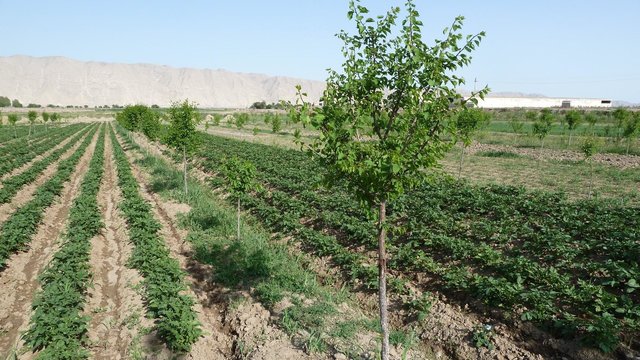
Rehabilitation of poor soils through agroforestry [ຕາຈິກິສະຕານ]
An agroforestry system with peach, plum, sweet cherry and persimmon trees was established on a plot of land, with poor soil quality.
- ຜູ້ສັງລວມຂໍ້ມູນ: Natalia Mityakova
2. ພັນລະນາ ແນວທາງການຄຸ້ມຄອງນໍາໃຊ້ດິນແບບຍືນຍົງ
2.1 ການອະທິບາຍ ໂດຍຫຍໍ້ ຂອງວິທີທາງ
Farmer Field Schools (FFS) are held to fill farmer's gaps in knowledge on the use of sustainable agricultural technologies, efficient irrigation water use and prevention of land degradation using trials tailored to local conditions.
2.2 ການອະທິບາຍ ລາຍລະອຽດ ຂອງວິທີທາງ
ການອະທິບາຍ ລາຍລະອຽດ ຂອງວິທີທາງ:
Aims / objectives: Farmer field schools are part of the UNDP-GEF project on “Demonstrating Local Responses to Combating Land Degradation and Improving Sustainable Land Management in SW Tajikistan”. They were established with the aim to address the dissemination of sustainable agricultural technologies, and the introduction of new crops. Currently, many farmers in Tajikistan may not previously have been farmers during Soviet times and therefore may lack detailed agricultural knowledge and experience.
Methods: The FFS training is voluntary and the opportunities to attend are announced at Jamoat level. Each year 4 different groups, each comprising 10 to 20 farmers are formed in 4 different Jamoats. The learning comprises a range of activities from classroom teaching to hands-on field experience. The content of the training sessions are effectively adapted to the relevant season and crops as well as to the pests that may occur. The field school addresses some of the following topics; cultivation of winter wheat, potatoes, tomatoes and melons, adequate post harvest handling, use of trees and shelterbelts, generation of quality seeds, pest management, efficient use of irrigation water, etc. The field from which the FFS participants learn about agriculture in practice is a 0.5 ha plot provided by one of the farmers.
Stages of implementation: Before the start of the FFS, 4 local agronomists from target Jamoats were recruited by UNDP and sent on a study tour to Russia. These agronomists in their capacity as a Local FFS Consultant started running FFSs in each Jamoat. Initially, in conjunction with the National FFS Consultant of the SLM project, the local consultants organised several meetings with local farmers in order to identify their training needs. Taking into account the needs of farmers the curricula was prepared and the training schedule was agreed with the farmers/participants.
Role of stakeholders: The project engaged women who are generally considered landless and vulnerable. They were involved in the demo plots on the basis of agreement signed between a local women’s group and a farmer, who owned the land. According to this agreement 70% of the harvest is distributed among the women, and 30% remains for farmer. In addition, many training sessions on pest management, planting of tomatoes, potatoes etc were delivered to women at the demo plot. To ensure food security at the household level training on canning, preparation of juice and how to make jam were conducted. However, more male than female farmers participated in the FFS. This is linked to the fact that the role of male farmers on Dehkan farms is to take decisions on cropping patterns and instruct other farmers. Therefore better dissemination of knowledge is expected from male farmers participating.
Other important information: The project has been efficient in providing micro-loans through an agreement with the micro-loan organisation “Rushdi Obshoron” for agricultural purposes in all four Jamoats, In total, 100,000USD has been distributed to 4 Jamoats.
2.3 ຮູບພາບຂອງແນວທາງ
2.5 ປະເທດ / ເຂດ / ສະຖານທີ່ບ່ອນທີ່ແນວທາງໄດ້ຖືກນໍາໃຊ້
ປະເທດ:
ຕາຈິກິສະຕານ
ພາກພື້ນ / ລັດ / ແຂວງ:
Khatlon
ຂໍ້ມູນເພີ່ມເຕີມຂອງສະຖານທີ່:
Shaartuz
Map
×2.6 ວັນທີເລີ່ມຕົ້ນ ແລະ ສິ້ນສຸດ ການຈັດຕັ້ງປະຕີບັດ ວິທີທາງ
ສະແດງປີຂອງການເລີ່ມຕົ້ນ:
2007
ປີທີ່ສີ້ນສູດ (ຖ້າຢຸດບໍ່ໄດ້ນໍາໃຊ້ ວິທີທາງ):
2011
2.7 ປະເພດຂອງແນວທາງ
- ພາຍໃຕ້ໂຄງການ / ແຜນງານ
2.8 ເປົ້າໝາຍ / ຈຸດປະສົງຫຼັກ ຂອງການຈັດຕັ້ງປະຕິບັດ ວິທີທາງ
The Approach focused mainly on other activities than SLM (agricultural production, market regulation, value chain development, seed multiplication )
The main aim of the approach is to support a change in mindset from a collective farming (Kolhoz) approach led by the state, onto private farmers putting more responsibility with the land users themselves. Since the collapse of the Soviet Union, many collective farms disintegrated and as a result of land reforms, the Dehkan farms came into being. People without an agricultural background could set up their own Dehkan farms and become farmers. However, a lack of knowledge and expertise frequently led to inappropriate land use which has contributed to land degradation. The objectives of FFS are to provide training sessions to farmers to improve their knowledge of better farming practices and the more rational use of land and water resources.
The SLM Approach addressed the following problems: lack of technical agricultural and ‘market economy’ knowledge, poverty
2.9 ເງື່ອນໄຂອໍານວຍ ຫຼື ຂັດຂວາງການປະຕິບັດຂອງເຕັກໂນໂລຢີ / ເຕັກໂນໂລຢີການນໍາໃຊ້ຕາມແນວທາງ
ສັງຄົມ / ວັດທະນະທໍາ / ມາດຕະຖານ ແລະ ຄຸນຄ່າທາງສາສະໜາ
- ເຊື່ອງຊ້ອນ
Many women in the region do not own their own land and can therefore be very vulnerable
Treatment through the SLM Approach: They were involved in the FFS receiving special training on pest management, planting of tomatoes, potatoes, vegetable canning, preparation of juice etc. A benefit sharing agreement was signed between the women’s group and the farmer who owned the land
ມີຄວາມສາມາດ / ເຂັ້າເຖິງຊັບພະຍາກອນດ້ານການເງິນ ແລະ ການບໍລິການ
- ເຊື່ອງຊ້ອນ
Lack of financial resources to buy fuel, fertilisers, livestock etc.
Treatment through the SLM Approach: A microloan organisation is providing credit loans from 2000-9000 Somoni (450-2,000 USD)
ກ່ຽວກັບກົດໝາຍ (ສິດນໍາໃຊ້ດິນ, ສິດນໍາໃຊ້ນໍ້າ)
- ເຊື່ອງຊ້ອນ
The existing land ownership, land use rights / water rights moderately hindered the approach implementation Initially, farmers had no freedom to farm, meaning they were not allowed to choose which crops they would grow, however, after the economic crisis this changed.
ຄວາມຮູ້ກ່ຽວກັບການຄຸ້ມຄອງ ທີ່ດິນແບບຍືນຍົງ, ການເຂົ້າເຖິງການສະໜັບສະໜູນ ທາງດ້ານວິຊາການ
- ເຊື່ອງຊ້ອນ
In general farmer’s agricultural knowledge is weak. Especially as after the collapse of the Soviet Union anybody could get some land and become a farmer, even people who did not have a traditional farming background and therefore no agricultural knowledge
Treatment through the SLM Approach: In the field schools farmers are receiving training about new agricultural technologies and have the chance to get advice about their particular problems
ອື່ນໆ
- ເຊື່ອງຊ້ອນ
No quality seeds were available
Treatment through the SLM Approach: UNDP provided seeds and ensured that a multiplication mechanism took place
3. ການມີສ່ວນຮ່ວມ ແລະ ບົດບາດຂອງພາກສ່ວນທີ່ກ່ຽວຂ້ອງທີ່ໄດ້ມີສ່ວນຮ່ວມ
3.1 ຜູ້ມີສ່ວນຮ່ວມ ໃນວິທີທາງ ແລະ ພາລະບົດບາດ ຂອງເຂົາເຈົ້າ
- ຜູ້ນໍາໃຊ້ດິນໃນທ້ອງຖິ່ນ / ຊຸມຊົນທ້ອງຖິ່ນ
Local agronomists from Jamoat level were sent to Russia on a study trip to learn from Russian experiences with sustainable land management
Landless women, individual farmers
Only 1/3 of the participants were women. This is linked to the fact that the role of male farmers on Dehkan farms is to take decisions on cropping patterns and instruct other farmers. Therefore better dissemination of knowledge is expected from male farmers participating.
Landless women who are very vulnerable.
- ຜູ້ຊ່ຽວຊານ ການນຄຸ້ມຄອງ ທີ່ດິນແບບຍືນຍົງ / ທີ່ປຶກສາດ້ານກະສິກໍາ
International specialists
National and local level consultants
- ອົງການຈັດຕັ້ງ ທີ່ບໍ່ຂື້ນກັບລັດຖະບານ
National agronomists working as consultants for UNDP
- ອົງການຈັດຕັ້ງ ສາກົນ
UNDP
ຖ້າຫາກມີຫຼາຍພາກສ່ວນທີ່ເຂົ້າຮ່ວມ ໃຫ້ລະບຸ ອົງການທີ່ເປັນຫຼັກ ໃນການຈັດຕັ້ງປະຕິບັດ:
UNDP
3.2 ການມີສ່ວນຮ່ວມຂອງຜູ້ນໍາໃຊ້ທີ່ດິນໃນທ້ອງຖິ່ນ / ຊຸມຊົນທ້ອງຖິ່ນໃນໄລຍະທີ່ແຕກຕ່າງກັນຂອງແນວທາງ
| ການລວບລວມ ເອົາຜູ້ນໍາໃຊ້ດິນ ໃນທ້ອງຖິ່ນ / ຊຸມຊົນທ້ອງຖິ່ນ | ໃຫ້ລະບຸ ຜູ້ໃດທີ່ມີສ່ວນຮ່ວມ ໃນແຕ່ລະກິດຈະກໍາ? | |
|---|---|---|
| ການເລີ່ມຕົ້ນ / ແຮງຈູງໃຈ | ການບໍ່ປະຕິບັດ | |
| ການວາງແຜນ | ການບໍ່ປະຕິບັດ | |
| ການປະຕິບັດ | ການບໍ່ປະຕິບັດ | Farmers only participated in FFS and were not involved in developing the content of training |
| ຕິດຕາມກວດກາ / ການປະເມີນຜົນ | ການຮ່ວມມື | No monitoring of the theoretical part of the approach took place, monitoring of land users success in applying the taught practices included interactive participation of land users. |
| Research | ການຮ່ວມມື | Some research on crop performance was undertaken with interactive involvement of land users. |
3.3 ແຜນວາດ (ຖ້າມີ)
ການອະທິບາຍ:
Before the start of the FFS 4 local agronomists from target Jamoats were recruited by UNDP and sent on a study tour to Russia. These local FFS consultants then started running a FFS in each Jamoat.
ຜູ້ຂຽນ:
Julie Zähringer (Baumackerstr. 51, 8050 Zürich)
3.4 ການຕັດສິນໃຈກ່ຽວກັບການຄັດເລືອກເຕັກໂນໂລຢີຂອງການຄຸ້ມຄອງທີ່ດິນແບບຍືນຍົງ / ເຕັກໂນໂລຢີ
ລະບຸ ຄົນທີ່ຕັດສິນໃຈ ກ່ຽວກັບການຄັດເລືອກຂອງ ເຕັກໂນໂລຢີ / ເຕັກໂນໂລຢີ ຈະໄດ້ຮັບການປະຕິບັດ:
- ຜູ້ຊ່ຽວຊານ ຫຼັກດ້ານການຄຸ້ມຄອງ ທີ່ດິນແບບຍືນຍົງ, ມີການຕິດຕາມປຶກສາຫາລືກັບຜູ້ນໍາໃຊ້ທີ່ດິນ
ອະທິບາຍ:
Decisions on the method of implementing the SLM Technology were made by mainly by SLM specialists with consultation of land users
4. ການສະໜັບສະໜູນທາງດ້ານວິຊາການ, ການສ້າງຄວາມສາມາດ, ແລະ ການຈັດການຄວາມຮູ້.
4.1 ການສ້າງຄວາມສາມາດ / ການຝຶກອົບຮົມ
ຜູ້ນໍາໃຊ້ທີ່ດິນ ຫຼື ພາກສ່ວນກ່ຽວຂ້ອງອື່ນໆ ໄດ້ຮັບການຝຶກອົບຮົມບໍ່?
ແມ່ນ
ໃຫ້ລະບຸ ຜູ້ໃດທີ່ໄດ້ຮັບການຝຶກອົບຮົມ:
- ຜູ້ນໍາໃຊ້ດິນ
- ພະນັກງານພາກສະໜາມ / ທີ່ປຶກສາ
ຮູບແບບຂອງການຝຶກອົບຮົມ:
- ການເຮັດຕົວຈິງ
- ຕົວຕໍ່ຕົວ
- ເນື້ອທີ່ສວນທົດລອງ
- ຫຼັກສູດ
ໃນຫົວຂໍ້:
Sustainable irrigation water use, integrated crop management, tree planting for biodrainage, preventing gully formation, crop storage, effective seed production, pest management
4.2 ການບໍລິການໃຫ້ຄໍາປຶກສາ
ເຮັດຜູ້ໃຊ້ທີ່ດິນມີການເຂົ້າເຖິງການບໍລິການໃຫ້ຄໍາປຶກສາ?
ແມ່ນ
ລະບຸວ່າການສະໜອງ ການບໍລິການ ໃຫ້ຄໍາປຶກສາ:
- ໃນພື້ນທີ່ຂອງຜູ້ນໍາໃຊ້ດິນ
ອະທິບາຍ / ຄວາມຄິດເຫັນ:
Farmer Field Schools: Key elements: Classroom courses, Farmer to farmer visits, Demonstration plots; Research is done on demonstration plots. Farmer to farmer visits are needed for an exchange of experience between different farmers.
Advisory service is quite adequate to ensure the continuation of land conservation activities; As they were provided with adequate training, the local level consultants are now able to continue holding training in farmer field schools. If the provision of micro-loans and the pay-back scheme keep working, funding will be available to ensure continuation.
4.3 ສະຖາບັນການສ້າງຄວາມເຂັ້ມແຂງ (ການພັດທະນາອົງການຈັດຕັ້ງ)
ສະຖາບັນ ໄດ້ຮັບການສ້າງຕັ້ງຂື້ນ ຫຼື ໄດ້ຮັບການສ້າງຄວາມເຂັ້ມແຂງ ໂດຍການຈັດຕັ້ງປະຕິບັດ ວິທີທາງບໍ່?
- ມີ, ພໍສົມຄວນ
ລະບຸ ທາງສະຖາບັນ ໄດ້ສ້າງຄວາມເຂັ້ມແຂງ ໃນລະດັບໃດ (ຫຼາຍ):
- ທ້ອງຖິ່ນ
ລະບຸ ປະເພດ ຂອງສະໜັບສະໜູນ:
- ທາງດ້ານການເງິນ
- ການສ້າງຄວາມອາດສາມາດ / ການຝຶກອົບຮົມ
ໃຫ້ລາຍລະອຽດເພີ່ມເຕີມ:
infrastructure, classrooms
4.4 ຕິດຕາມກວດກາ ແລະ ປະເມີນຜົນ
ການຈັດຕັ້ງປະຕິບັດ ວິທີທາງ ໄດ້ມີການປະເມີນຜົນ ແລະ ຕິດຕາມບໍ?
ແມ່ນ
ຄວາມຄິດເຫັນ:
technical aspects were regular monitored by project staff through measurements; indicators: on farm productivity
bio-physical aspects were ad hoc monitored by land users through observations; indicators: market situation
economic / production aspects were regular monitored by project staff through observations; indicators: None
no. of land users involved aspects were regular monitored by project staff through measurements; indicators: None
There were no changes in the Approach as a result of monitoring and evaluation: None
There were several changes in the Technology as a result of monitoring and evaluation: Exchange of experiences between different Jamoats (Jamoats differed in types of crops cultivated).
4.5 ການຄົ້ນຄວ້າ
ນີ້້ແມ່ນສ່ວນໜຶ່ງ ການຄົ້ນຄວ້າ ຂອງວິທີທາງບໍ່?
ແມ່ນ
ລະບຸ ຫົວຂໍ້:
- ເສດຖະສາດ / ການຕະຫຼາດ
- ລະບົບນິເວດ
- ເຕັກໂນໂລຢີ
ໃຫ້ຂໍ້ມູນ ເພີ່ມເຕີມ ແລະ ກໍານົດ ຜູ້ໃດເຮັດການຄົ້ນຄວ້າ:
Experiments about intercropping of different crop species. Local consultants also undertook research on marketing of different crops, which crop should be grown, and when for example, in order to achieve the best prices.
Research was carried out on-farm
5. ການສະໜັບສະໜູນທາງດ້ານການເງິນ ແລະ ອຸປະກອນຈາກພາຍນອກ
5.1 ງົບປະມານປະຈໍາປີ ສໍາລັບວິທີທາງ ຂອງການຄຸ້ມຄອງ ທີ່ດິນແບບຍືນຍົງ
ຖ້າຫາກບໍ່ຮູ້ຈັດງົບປະມານທີ່ແນ່ນອນ ແມ່ນໃຫ້ປະມານເອົາ:
- 100,000-1,000,000
ຄໍາເຫັນ (ຕົວຢ່າງ: ແຫຼ່ງຂໍ້ມູນຫຼັກ ຂອງການສະໜອງທຶນ / ຜູ້ໃຫ້ທຶນທີ່ສໍາຄັນ):
Approach costs were met by the following donors: international (GEF / UNDP): 100.0%
5.2 ການສະໜັບສະໜູນ ທາງດ້ານການເງິນ / ອຸປະກອນ ສະໜອງໃຫ້ແກ່ຜູ້ນໍາທີ່ດິນ
ຜູ້ນໍາໃຊ້ດິນ ໄດ້ຮັບການສະໜັບສະໜູນ ທາງດ້ານ ການເງິນ / ອຸປະກອນ ໃນການຈັດຕັ້ງປະຕິບັດ ເຕັກໂນໂລຢີບໍ?
ບໍ່ແມ່ນ
5.3 ເງິນສົມທົບສໍາລັບການນໍາໃຊ້ສະເພາະປັດໃຈຂາເຂົ້າໃນການຜະລີດກະສິກໍາ (ລວມທັງແຮງງານ)
- ແຮງງານ
| ທີ່ຂອບເຂດ | ລະບຸ ການອຸດໜູນ |
|---|---|
| ງົບປະມານເຕັມສ່ວນ | Salary of consultants |
- ອຸປະກອນ
| ໃຫ້ລະບຸໄດ້ຮັບການສະໜັບສະໜູນປັດໃຈຂາເຂົ້າຫຍັງແດ່ | ທີ່ຂອບເຂດ | ລະບຸ ການອຸດໜູນ |
|---|---|---|
| ເຄື່ອງກົນຈັກ | not financed | |
- ກະສິກໍາ
| ໃຫ້ລະບຸໄດ້ຮັບການສະໜັບສະໜູນປັດໃຈຂາເຂົ້າຫຍັງແດ່ | ທີ່ຂອບເຂດ | ລະບຸ ການອຸດໜູນ |
|---|---|---|
| ແນວພັນ, ແກ່ນພັນ | ງົບປະມານເຕັມສ່ວນ | |
- ພື້ນຖານໂຄງລ່າງ
| ໃຫ້ລະບຸໄດ້ຮັບການສະໜັບສະໜູນປັດໃຈຂາເຂົ້າຫຍັງແດ່ | ທີ່ຂອບເຂດ | ລະບຸ ການອຸດໜູນ |
|---|---|---|
| classrooms | ງົບປະມານເຕັມສ່ວນ | |
- ອື່ນໆ
| ອື່ນໆ (ລະບຸ) | ທີ່ຂອບເຂດ | ລະບຸ ການອຸດໜູນ |
|---|---|---|
| Study trip for local consultants to Russia | ງົບປະມານເຕັມສ່ວນ |
ຖ້າແຮງງານ ຂອງຜູ້ນໍາໃຊ້ດິນ ໄດ້ຮັບການສະໜັບສະໜູນ ປັດໃຈຂາເຂົ້າ, ແມ່ນບໍ່:
- ການອາສາ
5.4 ສິນເຊື່ອ
ໄດ້ປ່ອຍສິນເຊື່ອ ສະໜອງໃຫ້ພາຍໃຕ້ ວິທີການສໍາລັບກິດຈະກໍາ ການຄຸ້ມຄອງ ທີ່ດິນແບບຍືນນຍົງບໍ່?
ແມ່ນ
ເງື່ອນໄຂກໍານົດ (ອັດຕາດອກເບ້ຍ, ຈ່າຍຄືນ, ແລະ ອື່ນໆ) :
Interest rate charged: 1.5%; repayment conditions: A microloan organisation was established and equiped by UNDP with a starting capital of USD 200,000. The interest rate is 1.5% per month, which is considered low compared to credits provided by other financial institutions. Moreover, it requires very limited papers to be provided for get a loan. Farmers pay back loans in cash. .
Interest was lower than market rate.
5.5 ສິ່ງຈູງໃຈ ຫຼື ເຄື່ອງມືອື່ນໆ
ການສົ່ງເສີມ ຈັດຕັ້ງປະຕິບັດ ເຕັກໂນໂລຢີ ໃນການຄຸ້ມຄອງ ດິນແບບຍືນຍົງ ໄດ້ສະໜອງສິ່ງກະຕຸກຊຸກຍູ້ບໍ່?
ບໍ່ແມ່ນ
6. ວິເຄາະຜົນກະທົບ ແລະ ສັງລວມບັນຫາ
6.1 ຜົນກະທົບຂອງແນວທາງ
ການຈັດຕັ້ງປະຕິບັດ ວິທີທາງ ສາມາດຊ່ວຍຜູ້ນໍາໃຊ້ທີ່ດິນ ໃນການຈັດຕັ້ງປະຕິບັດ ແລະ ບໍາລຸງຮັກສາ ເຕັກໂນໂລຢີ ການຄຸ້ມຄອງ ທີ່ດິນແບບຍືນຍົງໄດ້ບໍ?
- ບໍ່
- ມີ, ໜ້ອຍໜຶ່ງ
- ມີ, ພໍສົມຄວນ
- ມີ, ຫຼາຍ
More holistic thinking, including crop selection, cultural practices, conservation, integrated pest management etc. However, the number of farmers participating in field schools is still somewhat limited.
ການຈັດຕັ້ງປະຕິບັດ ວິທີທາງ ສາມາດສ້າງຄວາມເຂັ້ມແຂງ ທາງສັງຄົມ ແລະ ເສດຖະກິດບໍ່?
- ບໍ່
- ມີ, ໜ້ອຍໜຶ່ງ
- ມີ, ພໍສົມຄວນ
- ມີ, ຫຼາຍ
Landless women were engaged in the field schools. The women groups kept 70% of the crop yield, while 30% was paid to the landowner of the demonstration plot. Food security increased for the women.
ການຈັດຕັ້ງປະຕິບັດ ວິທີທາງ ສາມາດປັບປຸງ ປະເດັນການຖືຄອງທີ່ດິນ / ສິດທິໃນການນໍາໃຊ້ທີ່ດິນ ທີ່ເຊື່ອງຊ້ອນໃນການຈັດຕັ້ງປະຕິບັດ ເຕັກໂນໂລຢີ ການຄຸ້ມຄອງ ທີ່ດິນແບບຍືນຍົງໄດ້ບໍ?
- ບໍ່
- ມີ, ໜ້ອຍໜຶ່ງ
- ມີ, ພໍສົມຄວນ
- ມີ, ຫຼາຍ
The approach could not reduce the problem, it was a governmental decision. The problem is likely to be overcome in the near future.
Did other land users / projects adopt the Approach?
- ບໍ່
- ມີ, ໜ້ອຍໜຶ່ງ
- ມີ, ພໍສົມຄວນ
- ມີ, ຫຼາຍ
The approach has not yet been disseminated over the country.
Did the Approach lead to improved livelihoods / human well-being?
- ບໍ່
- ມີ, ໜ້ອຍໜຶ່ງ
- ມີ, ພໍສົມຄວນ
- ມີ, ຫຼາຍ
higher crop yields
Did the Approach help to alleviate poverty?
- ບໍ່
- ມີ, ໜ້ອຍໜຶ່ງ
- ມີ, ພໍສົມຄວນ
- ມີ, ຫຼາຍ
Higher income through increased crop production.
6.2 ແຮງຈູງໃຈຫຼັກຂອງຜູ້ນໍາໃຊ້ທີ່ດິນໃນການປະຕິບັດການຄຸ້ມຄອງທີ່ດິນແບບຍືນຍົງ
- ການຜະລິດເພີ່ມຂຶ້ນ
- ກຽດສັກສີ, ຄວາມກົດດັນທາງສັງຄົມ / ການຕິດຕໍ່ກັນທາງສັງຄົມ
- agricultural knowledge
- well-being and livelihoods improvement
6.3 ຄວາມຍືນຍົງຂອງກິດຈະກໍາວິທີທາງ
ຜູ້ນໍາໃຊ້ ທີ່ດິນ ສາມາດສືບຕໍ່ ການຈັດຕັ້ງປະຕິບັດ ຜ່ານວິທີທາງໄດ້ບໍ່ (ໂດຍປາດສະຈາກ ການຊ່ວຍເຫຼືອ ຈາກພາກສ່ວນພາຍນອກ)?
- ແມ່ນ
ຖ້າ ໄດ້, ອະທິບາຍເຫດຜົນ:
Farmers who were trained in the field schools are now able to disseminate their knowledge to other farmers. For this they receive some 'in kind' contribution from the farmers they teach such as seeds etc.
6.4 ຈຸດແຂງ / ຂໍ້ດີ ຂອງວິທີທາງ
| ຈຸດແຂງ / ຂໍ້ດີ / ໂອກາດໃນການນໍາໃຊ້ທີ່ດິນ |
|---|
| Increased crop yields lead to increased family budget (How to sustain/ enhance this strength: Ensure application of taught practices.) |
| The farmers feel confident about what they do and are keen to disseminate their knowledge to other farmers (How to sustain/ enhance this strength: Dissemination of knowledge to other farmers so that more people can profit, for example through farmer to farmer visits) |
| The farmers know which crops to cultivate and how to adapt to the market conditions. |
| Integrated pest management helps to fight diseases and leads to better onion yield (How to sustain/ enhance this strength: Apply integrated pest management on all fields.) |
| ຈຸດແຂງ / ຈຸດດີ / ໂອກາດ ຈາກທັດສະນະຂອງຜູ້ປ້ອນຂໍ້ມູນ ຫຼື ບຸກຄົນສຳຄັນ |
|---|
| The farmers are trained on the rational use of land and water resources which helps to reduce land degradation. (How to sustain/ enhance this strength: An emphasis has to be put on the prevention of land degradation.) |
| Farmers from different backgrounds enrich their farming practices and fill gaps in agricultural knowledge Topics taught in FFS should be diversified and continually updated. (How to sustain/ enhance this strength: Topics taught in FFS should be diversified and always be up to date.) |
6.5 ຈຸດອ່ອນ / ຂໍ້ເສຍຂອງແນວທາງ ແລະ ວິທີການແກ້ໄຂໃຫ້ເຂົາເຈົ້າ
| ຈຸດອ່ອນ ຫຼື ຂໍ້ເສຍ ຫຼື ຄວາມສ່ຽງ ໃນມຸມມອງຂອງ ຜູ້ສັງລວມຂໍ້ມູນ ຫຼື ບັນດາຜູ້ຕອບແບບສອບຖາມ | ມີວິທີການແກ້ໄຂຄືແນວໃດ? |
|---|---|
| Until now the FFS were running free of charge to the participants, however, this should be changed in order to raise more money to continue with the field schools, but farmers might not be willing to pay immediately, it takes some time before the farmers realise the significance of the FFS | Farmers would be more willing to pay if they were asked for in kind contributions, rather tha cash. |
7. ເອກກະສານອ້າງອີງ ແລະ ຂໍ້ມູນການເຊື່ອມໂຍງ
7.1 ວິທີການ / ແຫຼ່ງຂໍ້ມູນ
- ການໄປຢ້ຽມຢາມພາກສະໜາມ, ການສໍາຫຼວດພາກສະໜາມ
- ການສໍາພາດ ຜູ້ນໍາໃຊ້ທີ່ດິນ
ຂໍ້ມູນການເຊື່ອມຕໍ່ ແລະ ເນື້ອໃນ
ຂະຫຍາຍທັງໝົດ ຍຸບທັງໝົດການເຊື່ອມຕໍ່

Pest management with pheromone insect traps [ຕາຈິກິສະຕານ]
Coloured pheromone traps are set up in agricultural fields to attract and eradicate flying insect pests.
- ຜູ້ສັງລວມຂໍ້ມູນ: Firdavs Faizulloev

Rehabilitation of poor soils through agroforestry [ຕາຈິກິສະຕານ]
An agroforestry system with peach, plum, sweet cherry and persimmon trees was established on a plot of land, with poor soil quality.
- ຜູ້ສັງລວມຂໍ້ມູນ: Natalia Mityakova
ເນື້ອໃນ
ບໍ່ມີເນື້ອໃນ


